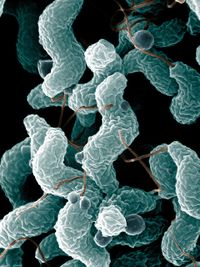Difference between revisions of "Campylobacteriosis - Cattle"
| Line 15: | Line 15: | ||
==Control== | ==Control== | ||
| − | The disease can be prevented with good husbandry and | + | The disease can be prevented with good husbandry and disinfection and cleaning protocols. |
[[Category:To Do - Jaimie Meagor]] | [[Category:To Do - Jaimie Meagor]] | ||
Revision as of 16:40, 8 June 2011
Introduction
Gastrointestinal campylobacteriosis is caused by Campylobacter jejuni or Campylobacter coli. It causes diarrhoea mainly in young animals and can infect cattle as well as other species such as dogs, cats, sheep, goat, ferrets, rabbits, hamsters, and mink. Although C. jejuni rarely causes fatal disease in animals, it the leading cause of foodborne diseases in humans and causes diarrhoea and cramps. Humans can become infected by faecal contaminated poultry skin, meat, milk and water sources. It can also be spread by humans via poor hygiene and during food processing. C. jejuni may also cause abortion and mastitis in cattle. Campylobacter can also cause venereal disease and abortions in cattle. Fetus subsp venearalis causes Bovine Genital Campylobacteriosis and C.fetus subsp fetus causes abortion (although the incidence is much lower than in sheep).
Signalment
C.jejuni and C.coli can cause diarrhoea in both adult and calves but is also a commensal in many species and can be found in healthy animal gastrointestinal tracts. Campylobacter is spread via the faecal oral route.
Clinical signs
Calves are more seriously affected and suffer from thick mucoid diarrhoea, often flecked with blood and can have pyrexia or a normal body temperature. Cattle may also suffer from tachycardia, rapid pulse rates and tachypnoea and weight loss. Adult cattle can become anorexic and show various reproductive signs such as anoestrus, irregular oestrus patterns, hot udders, agalactia, abortion and infertility.
Diagnosis
Rising antibody titre can confirm the presence of campylobacter. C Jenuni can be isolated and cultured from placental and foetal tissue. It causes the stunting and fusion of villi, dilation of crypts and crypt abscesses and mild cellular infiltration of the mucosa. The profound lesions can be found in the proximal small intestines and colon and can be visualised as comma-shaped organisms on the surface of the epithelium and within the lamina propria using silver staining. In general selective media containing antimicrobial agents such as polymyxin B or trimethoprim can be used to identify Campylobacter organisms from affected intestinal samples, stomach content, smegma or vaginal fluid. C. fetus can be detected from cervicovaginal mucus using agglutination test or an ELISA.
Treatment
C. jejuni can be treated with erythromycin and tetracycline, but resistance has been recorded for both drugs.
Control
The disease can be prevented with good husbandry and disinfection and cleaning protocols.
